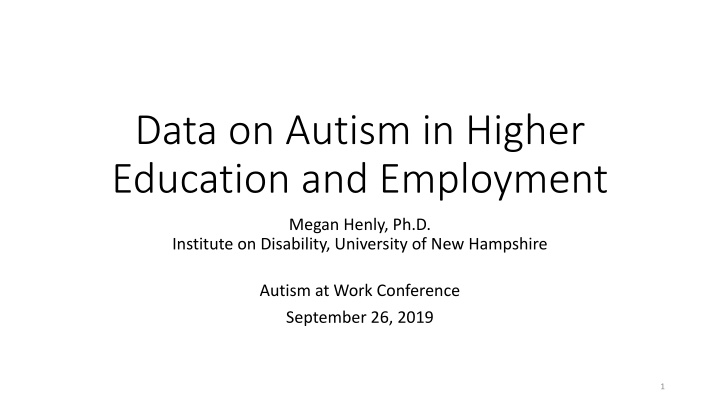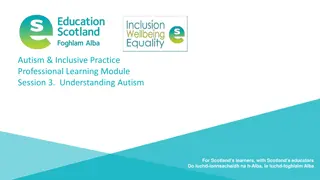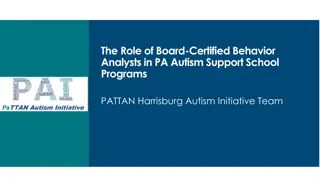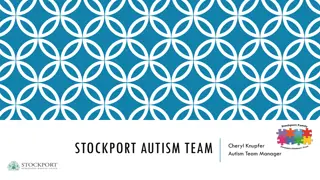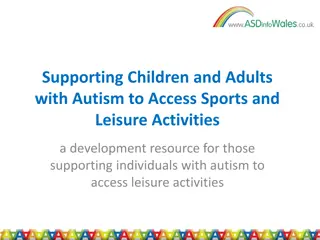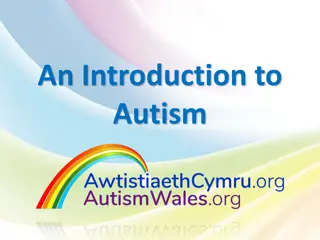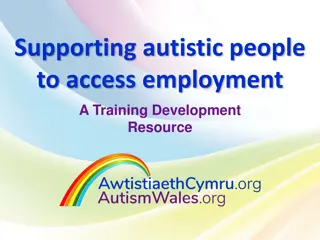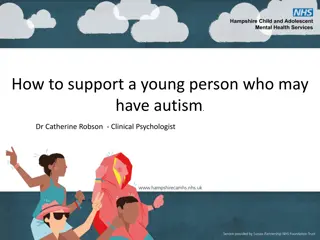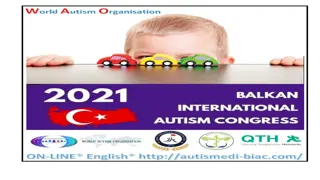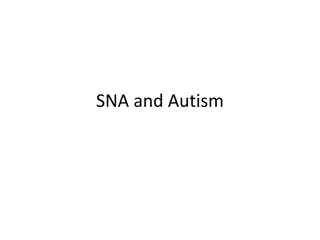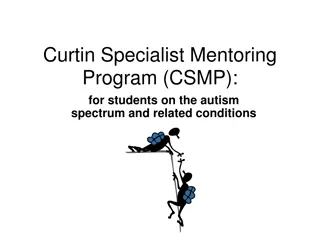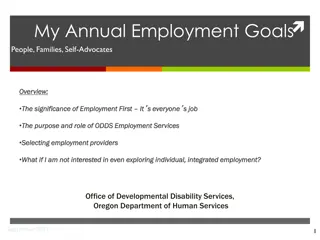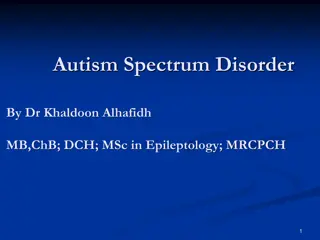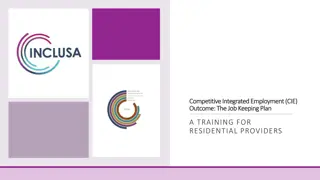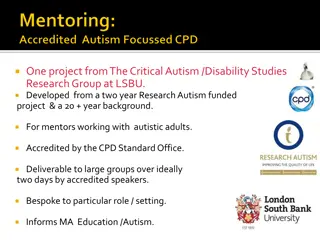Insights on Autism in Higher Education and Employment
Explore data sources, survey considerations, and sampling factors regarding autism in higher education and employment. Learn about commonly cited statistics on ASD prevalence and postsecondary education outcomes for individuals with ASD. Gain valuable insights from the Autism at Work Conference presentation by Dr. Megan Henly.
Download Presentation

Please find below an Image/Link to download the presentation.
The content on the website is provided AS IS for your information and personal use only. It may not be sold, licensed, or shared on other websites without obtaining consent from the author.If you encounter any issues during the download, it is possible that the publisher has removed the file from their server.
You are allowed to download the files provided on this website for personal or commercial use, subject to the condition that they are used lawfully. All files are the property of their respective owners.
The content on the website is provided AS IS for your information and personal use only. It may not be sold, licensed, or shared on other websites without obtaining consent from the author.
E N D
Presentation Transcript
Data on Autism in Higher Education and Employment Megan Henly, Ph.D. Institute on Disability, University of New Hampshire Autism at Work Conference September 26, 2019 1
Questions I would like to answer What do we (think we) know? Where do these statistics come from? What does this mean? 2
Where do data come from? Anecdotal data Small case studies Administrative records Survey data 3
Survey data: Special Considerations When interpreting survey data, consider: What is the sampling frame? Who counts ? 4
Sampling considerations that relate to interpretation People with ASD People Living in the U.S. 5
Sampling considerations that relate to interpretation x x x x x x x x x x x x People with ASD x x x x xx x x x x x x x x x x People Living in the U.S. x x x x x x x x x x x x x x x x x x x x x x x x x x x x x x x x x x x x x x 6
Sampling considerations that relate to interpretation People who use disability services People with ASD Diagnosis 7
Sampling considerations that relate to interpretation People who report having a disability People with ASD Diagnosis 8
Commonly cited statistics: ASD Prevalence ASD Prevalence: 1 in 59 (Autism and Developmental Disabilities Monitoring (ADDM) Network), CDC ASD Prevalence: 1 in 40 (National Survey of Children s Health) Other sources: Medicaid claims, Children receiving Individuals with Disabilities Education Act (IDEA) services 9
Commonly cited statistics: ASD Postsecondary education Attend college or get a job: 65% of High School grads with ASD Attend college: 35% of High School grads with ASD Obtain a college degree: 39% of college students with ASD 10
Commonly cited statistics: ASD and disability employment Attend college or get a job: 65% of High School grads with ASD Hold a job: 55% of High School grads with ASD Disability employment rate : 16.8% June 2014 11
General Population as Sampling Frame x x x x x x x x x x x x People with ASD x x x x xx x x x x x x x x x x People Living in the U.S. x x x x x x x x x x x x x x x x x x x x x x x x x x x x x x x x x x x x x x 12
General Population as Sampling Frame High School Longitudinal Survey of 2009 (HSLS09) Large scale, nationally-representative survey of children who were high school freshmen in 2009 We know ASD diagnosis status in 2009. Follow up surveys were issued in 2012 (11th grade) and the Spring of 2016 (about age 21). We can report college attendance and employment participation for those with ASD and compare it to peers with no ASD diagnosis. 13
Education and Work Characteristics in 2016, by Autism Diagnosis (among those who were HS Freshmen in 2009) No Autism 96.1% 78.7% 56.4% 89.3% 68.2% Autism 97.4% 58.2% 41.1% 79.8% 52.1% Has HS Diploma/GED Ever Attended College Currently Attending College Has had any job since high school Currently Working Source: Author s calculations of the 2009 High School Longitudinal Survey Note College participation rates computed among those who have HS diploma/GED only 14
Questions to ask when evaluating data What is the source? What is the sampling frame? How do they identify people with an ASD? 15
References / More Information ASD Prevalence https://www.cdc.gov/ncbddd/autism/data.html https://pediatrics.aappublications.org/content/142/6/e20174161 Info on methodology https://www.cdc.gov/ncbddd/autism/data/index.html#methodology Analysis of Special Education Students after High School (Education & Employment) Roux, Anne M., Shattuck, Paul T., Rast, Jessica E., Anderson, Kristy A. (2017). National Autism Indicators Report: Developmental Disability Services and Outcomes in Adulthood. Philadelphia, PA: Life Course Outcomes Research Program, A.J. Drexel Autism Institute, Drexel University. Newman, L., Wagner, M., Knokey, A.-M., Marder, C., Nagle, K., Shaver, D., Wei, X., with Cameto, R., Contreras, E., Ferguson, K., Greene, S., and Schwarting, M. (2011). The Post-High School Outcomes of Young Adults With Disabilities up to 8 Years After High School. A Report From the National Longitudinal Transition Study-2 (NLTS2) (NCSER 2011-3005). Menlo Park, CA: SRI International. Shattuck PT, Narendorf, SC, Cooper B, et al. (2012). Postsecondary education and employment among youth with an autism spectrum disorder. Pediatrics, 129(6) http://pediatrics.aappublications.org/content/129/6/1042 IDEA Data: https://nces.ed.gov/programs/coe/indicator_cgg.asp Disability employment data: https://researchondisability.org/home/ntide 16
Questions? Other data sources to share? Contact: Megan.Henly@unh.edu UNH Institute on Disability Durham, New Hampshire 17
